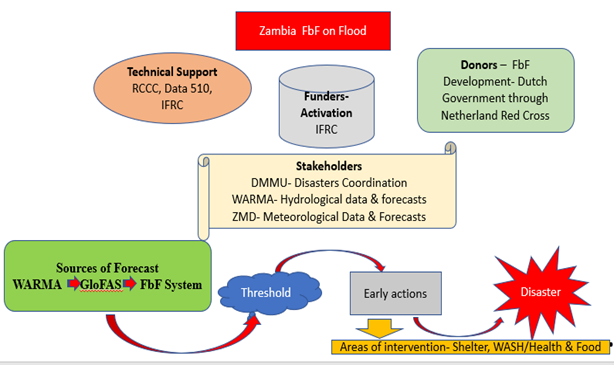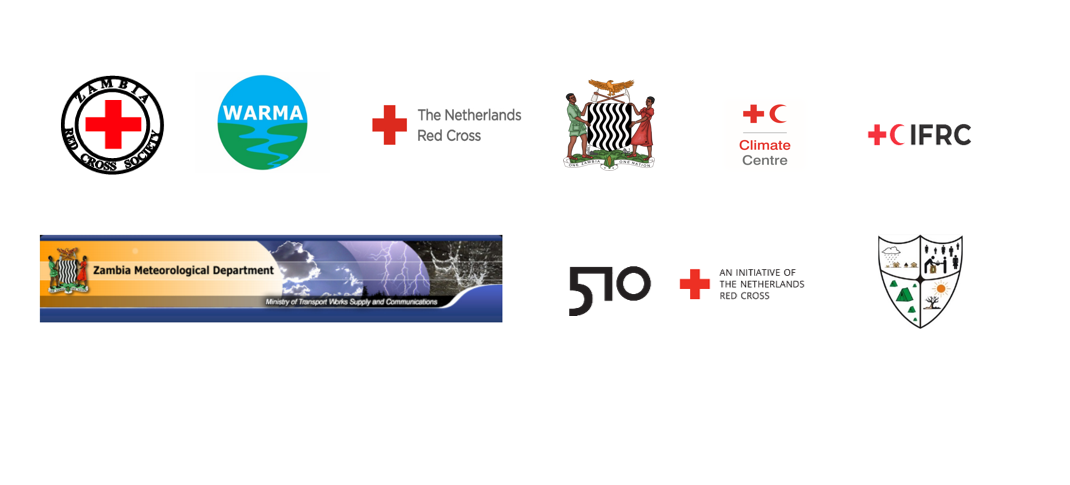Categories
Forecast-based Financing (FbF) in the Zambia – Taking advantage of the forecast to implement early actions to minimize the impact of anticipated disaster flood/drought
The project seeks to reduce the humanitarian consequences of climate related disasters and build community resilience through implementation of early action to reduce loss of life and property as a result of flood disasters in high risk areas in the country.
Key facts
Start/end date
September 2020 -August 2025
Hazards covered
Floods
Regions covered
Very High Risk: (13 Districts):
Namwala, Itezhi Tezhi, Monze, Mazabuka, Gwembe, Sinazongwe. Luangwa, Petauke, Nyimba, and Katete, Mambwe and Chama
High Risk: (20 Districts):
Chavuma, Zambezi, Mufumbwe, Mumbwa, Kabwe, Mkushi, Serenje, Senanga, Shangombo, Sesheke, : Kazungula, Choma and Siavonga, Lusaka and Kafue, Milenge, Samfya, Lundazi and Muchinga: Chinsali
Early action sectors
Shelter | WaSH | Health | Food security |Livelihoods
Anticipatory Action Protocols/Plans in place
Flood EAP approved in September 2020
Activations
Not activated yet. Simulation planned for December 2020/January 2021
Population reached during activation
Plans to reach 1000 HHs (6000 people)
Key actors/implementing partners
Red Cross Movement:
Zambia Red Cross Society, Netherland Red Cross, Red Cross Red Crescent Climate Centre, International Federation of the Red Cross, 510 initiative of the Netherlands Red Cross
Government:
WARMA (Water Resource Management Authority) DMMU (Disaster Management and Mitigation Unit) ZMD (Zambia Meteorological Department)
Other line Ministries:
Ministry of Health, Ministry of Community Development and Social services, Ministry of National Development and planning, Ministry of Agriculture, Ministry of local Government
Universities: Mulungushi University, University of Zambia
Early warning subcommittee members such as UN- WFP, UNICEF, and NGOs such as Save the Children, World Vision.

Anticipation in practice: Project description
Zambia is faced with various hazards and floods pose the biggest threat to people’s livelihoods. A risk analysis was conducted through interviews and literature review to understand the dynamics of flooding and its Impacts on people, infrastructure, and livelihoods. To develop the FbF in the country, ZRCS worked with the Technical Working Group on the following seven steps: risk analysis, developing a menu of triggers, selection and validation of early actions, developing the EAP, and monitoring of forecasts.
If the danger level is exceeded, the following early actions are implemented to reduce or prevent three priority impacts:
- Displacement of people due to destruction of shelter (partial or complete damage).
- Water borne disease outbreaks e.g. cholera due to contamination of water points and or increased malaria incidences due to increased exposure to mosquito attacks and
- Crop losses and damage due to water logging
Trigger development was done in close collaboration with Disaster Management Unit, Water Resources Management Authority and Zambia Meteorological Department
The trigger is based on the water discharge at 32 river stations that are linked to GloFAS (Global Flood Awareness System). When discharge rates indicate that a flood with a 10-year return period is likely to occur within days, the protocol is activated.
The following early actions were selected in consultation with communities:
- Community sensitization and dissemination of forecast information, early warning and early action messages to communities at risk
- Pre-positioning and distribution of non-food (NFIs) and WASH items such as (mats, plastic sheets, blankets, ITN, empty sacks to be used as flood embankments, tents), chlorine/water purification tablets, Jerry cans, and soap in case of evacuation
- Digging trenches/embankments to divert flood water (environmental control measures)
- Early harvesting of flood threatened crops (e.g. cassava, sweet potatoes, maize and beans)
- Distribution of food storage bags to allow for proper food storage and preservation in anticipation of floods
Outcomes and lessons learnt
FbF promoted engagement of and embeddedness with government stakeholders and structures, which contributed to increase visibility of the National Society and is considered a positive development. Evidence suggests that the relationships established through FbF are likely to continue.
Enhanced institutional integration for synergy formulation is vital for effectiveness and sustainability. There is need to build national skillset for enhanced prediction capacities and facilitate evidence-based intervention.
Competing needs within the National society led to delays in the development of the EAP.
Creation of and working through a technical working group affiliated with the early warning subcommittee propelled the EAP development process.
In Zambia, the RPII programme is credited for improved relationships and collaboration between stakeholders such as DMMU, WARMA, ZMD and ZRCS. This started from the consultation process during the design of the project, and has gradually increased due to the FBF working group of which all actors are part. The associated FBF app-group has facilitated a form of low-threshold communication that did not exist prior to the project, and keeps communication lines short and effective which is said to ensure more rapid responses and coordination.
I produced a map of flood prone areas, and Aki from 510 said that he had software to reduce the amount of information in the map to make it more clear. To do that myself would have cost me months, and now it was done in a couple of days. I continued updating with Aki afterwards. Now we also produced a magnitude map. I will be able to continue producing better maps in the future
.
Ensuring their commitment and ownership was an essential step to keep response preparedness activities, and collective action on FBF, on the agenda. By connecting WARMA and ZMD directly with partners such 510 and RCCC, capacity has been built at those institutions that are crucial for the continuation of response preparedness in the
Future
Further Information
- Looking forward to forecast-based financing in Zambia (news article)
- FbF potential in Africa boosted by new reporting points on rivers in four countries (news article)
- 1st African Dialogue Platform on Forecast-based Financing, 21 – 22 March 2018 in Nairobi, Kenya (Report)
- Future Climate for Africa, Pilot Phase: Zambia| Technical Report
Contact
Mulambwa Mwanang’ono
Disaster Management Manager
mulambwa.mwanang’ono@redcross.org.zm
Tel. + 260 970 455600 / +260 977 120346


